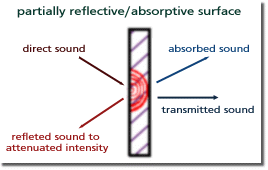| In recording situations in a room with poor
absorption this can lead to "muddiness" of the resulting
recorded sound. The solution to recording in an overly "live" room is to
place the microphone (microphone
placement) closely to the sound source. This will result
in a much greater ratio of wanted sound to unwanted ambient noise effectively
masking the acoustic quality of the surrounding space. |
Sometimes close micing is impractical when recording complex
sounding objects such as large instruments. In this
case adjustments to the absorptive characteristics of the room itself can
be made by covering the reflective surfaces with absorptive material such
as carpet, cardboard, or acoustic baffling. |
